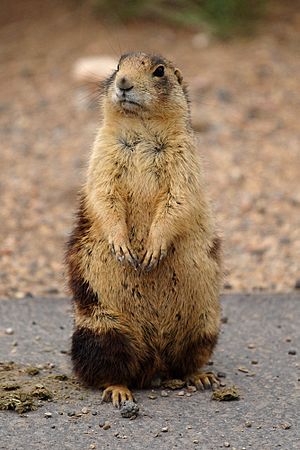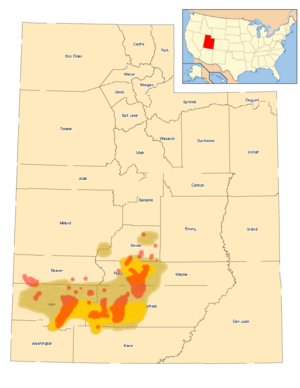Utah prairie dog facts for kids
Quick facts for kids Utah prairie dog |
|
|---|---|
 |
|
| Conservation status | |
| Scientific classification | |
| Genus: |
Cynomys
|
| Species: |
parvidens
|
 |
|
| Utah prairie dog range in 1920 (ochre), 1970 (yellow) and 1991 (red) | |
The Utah prairie dog (Cynomys parvidens) is the smallest type of prairie dog. It is a rodent that belongs to the squirrel family. These animals live in the south-central steppes of the US state of Utah.
Contents
Description
The Utah prairie dog has fur with many colors. It has black, brown, and dark brown tips. Its face has dark brown cheeks. Its chin and mouth areas are whitish.
Body size
Adult Utah prairie dogs are usually between 30.5 and 36.0 centimeters (about 12 to 14 inches) long. Their tails are short, from 3 to 6 centimeters (about 1 to 2 inches).
Male prairie dogs weigh about 0.77 to 1.41 kilograms (about 1.7 to 3.1 pounds). Females are a bit lighter, weighing 0.64 to 1.13 kilograms (about 1.4 to 2.5 pounds). This means males are generally bigger than females. This difference is called sexual dimorphism. Males can be up to 27% larger than females.
Ecology
Range and habitat
Utah prairie dogs like to live in low, grassy areas called swales. These areas have many herbaceous plants, which are plants with soft stems. They dig their homes, called burrows, in soil that drains water well. This helps protect them from bad weather and animals that might hunt them.
Today, Utah prairie dogs are only found in the central and southwestern parts of Utah. This includes counties like Beaver, Garfield, Iron, Kane, Piute, Sevier, and Wayne. In the past, they lived in more places, even as far north as Nephi. Their numbers dropped a lot from the 1920s to the 1970s. This was mostly because of human settlers. They let too many animals eat the grass, which is called overgrazing. This made it easier for shrubs to grow where grass used to be.
Diet
Utah prairie dogs are mostly herbivores, meaning they eat plants. They especially like grasses. However, they also eat flowers from shrubs. Sometimes, they even eat small insects like cicadas. They are picky eaters and only choose certain types of native grasses.
Reproduction
Utah prairie dogs usually have one group of babies, called a litter, each year. A litter can have 1 to 8 babies. Breeding usually happens from mid-March to early April.
Behavior
These prairie dogs build large "towns" underground. These towns are made of many tunnels and rooms. Each town is home to a group of prairie dogs from the same family, called a "clan." They spend their days, from sunrise to sunset, looking for food.
Conservation status
The Utah prairie dog is listed as an Endangered animal on the IUCN Red List of Threatened Species. This means it is at a high risk of becoming extinct. The United States Fish and Wildlife Service also lists it as a threatened species.
In 1972, there were only about 3,300 Utah prairie dogs in 37 groups. By 2004, studies showed about 4,022 prairie dogs. This number was thought to be only half of the total population at that time.
Utah prairie dogs can cause problems for farms by digging holes and eating crops. Because of this, farmers sometimes used methods to remove them. This was a major reason for their population decline. Other reasons include new buildings on their land, changes in their habitat, a disease called sylvatic plague, and dry weather (drought).
To help these animals, people are working on conservation efforts. They encourage landowners to keep their grasslands healthy. They also pay farmers who set aside areas for the prairie dogs to use.
- Manno, Theodore G. The Utah Prairie Dog: Life among the Red Rocks. Salt Lake City: University of Utah Press, 2014. ISBN: 978-1-60781-366-8
See also
 In Spanish: Perrito de la pradera de Utah para niños
In Spanish: Perrito de la pradera de Utah para niños


